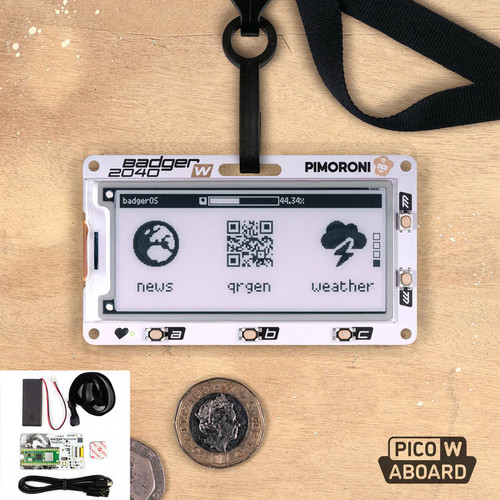

A programmable badge with fast updating E Ink® display and wireless connectivity, powered by Raspberry Pi Pico W.
Badger 2040 W is a maker-friendly all-in-one badge wearable, designed for efficient identification of humans and other lifeforms. It's great for powering by battery, as it can go into an ultra-low power sleep mode when the screen's not being refreshed. And because it's a handy microcontroller with a built-in screen that can fit right in your pocket, we bet you could use it for a bunch of other cool experimental projects too.
On the front, you'll find the black and white 2.9" e-paper screen, a selection of buttons to poke at, and a slot to clip it onto a lanyard. On the back, there's a battery connector, a reset button, and a Qw/ST connector for plugging in Qwiic or STEMMA QT breakouts. And now that it has a Raspberry Pi Pico W Aboard, it can communicate wirelessly with other devices and retrieve data from the internet, hoorah!
Pico W x E Ink®
It makes for a lovely, crisp, high contrast display that's nice and readable, and it doesn't squirt unnecessary blue light into your environs like LCDs do. It's also ultra-low power (EPD displays only consume power while they're refreshing), and the images on the display stick around for a really long time while the display is unpowered.
Using a Raspberry Pico W means we can drive the hardware in fun, experimental, low-level ways. We've written custom drivers for the EPD display that prioritise low power consumption whilst enabling lightning-fast refresh rates.
Features
- 2.9" black and white E Ink® display (296 x 128 pixels)
- Ultra-wide viewing angles
- Ultra-low power consumption
- Dot pitch - 0.227 x 0.226 mm
- Raspberry Pi Pico W Aboard
- Dual Arm Cortex M0+ running at up to 133MHz with 264kB of SRAM
- 2MB of QSPI flash supporting XiP
- Powered and programmable by USB micro-B
- 2.4GHz wireless
- Five front user buttons
- Reset button
- White LED
- JST-PH connector for attaching a battery (input range 2.7V - 5.5V)
- Qw/ST (Qwiic/STEMMA QT) connector
- Dedicated RTC chip (PCF85063A) for deep sleep / wake *
- Fully-assembled (no soldering required)
- Schematic
- Dimensional drawing
- C++/MicroPython libraries
Badger W + Accessory Kit includes
- Badger 2040 W
- 2 x AAA battery holder
- 2 x AAA batteries
- Velcro square
- Black lanyard (made from recycled plastic bottles!)
- USB-A to USB micro-B cable
Software
Badger W comes ready with MicroPython and BadgerOS examples, so you can start coding right away. Use PicoGraphics to display text, shapes, and images, or switch to C++ for maximum performance. WiFi is easy to set up by editing WIFI_CONFIG.py, and you can return to the launcher anytime by holding A+C.
MicroPython
- (Learn) Getting Started with Badger 2040 W
- (Readme) Installation instructions
- Download Badger flavoured MicroPython (with Badger OS examples)
- Badger 2040 function reference
- PicoGraphics function reference
C/C++
Connecting Breakouts
The Qw/ST connector lets you easily plug in Qwiic or STEMMA QT breakouts with a JST-SH cable. Breakout Garden boards can connect using a Qw/ST to Breakout Garden adaptor. Compatible breakouts are supported in both C++ and MicroPython.
- List of breakouts currently compatible with Pimoroni's C++/MicroPython build.
Notes
- Measurements: 85.6mm x 48.7mm x 10mm (L x W x H, including connectors). The mounting holes are M2.5 and 3.0mm in from each edge. The corner radius is 3mm.
- Badger W is fairly accommodating about input voltage (2.7V - 5.5V), so it's possible to use a variety of different batteries and battery packs. A 2x AAA battery pack fits behind Badger W nicely (double/triple AA and AAA battery packs will also work though). If you're using rechargeable (NiMH) batteries, we'd recommend using a 3x AAA battery pack.
- Alternatively, you can plug a LiPo/LiIon battery into the battery connector, with the following caveats. Please only consider this if the person wearing the badge is an adult and knows what they're doing with LiPos!
- A solid enclosure or backplate to protect the battery from damage whilst being worn is a very good idea.
- There's no battery protection included on Badger W, so you should only use it with LiPo batteries that include internal protection.
- Badger W doesn't have battery charging circuitry onboard (this is so it's safe to use with either alkaline or LiPo batteries). You'll need an external LiPo charger to charge the battery (like a LiPo Amigo).
- * Badger W's onboard RTC (Real Time Clock) means it can go into a super deep sleep mode that only draws about 20uA of power, turning off the power that drives the Pico W and the display completely. It can be woken back up by the RTC or the front buttons. You can also read the RTC to keep track of the time and date, of course!




